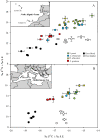Trophic structure in a seabird host-parasite food web: insights from stable isotope analyses
- PMID: 20454612
- PMCID: PMC2864259
- DOI: 10.1371/journal.pone.0010454
Trophic structure in a seabird host-parasite food web: insights from stable isotope analyses
Abstract
Ecological studies on food webs rarely include parasites, partly due to the complexity and dimensionality of host-parasite interaction networks. Multiple co-occurring parasites can show different feeding strategies and thus lead to complex and cryptic trophic relationships, which are often difficult to disentangle by traditional methods. We analyzed stable isotope ratios of C ((13)C/(12)C, delta(13)C) and N ((15)N/(14)N, delta(15)N) of host and ectoparasite tissues to investigate trophic structure in 4 co-occurring ectoparasites: three lice and one flea species, on two closely related and spatially segregated seabird hosts (Calonectris shearwaters). delta(13)C isotopic signatures confirmed feathers as the main food resource for the three lice species and blood for the flea species. All ectoparasite species showed a significant enrichment in delta(15)N relatively to the host tissue consumed (discrimination factors ranged from 2 to 5 per thousand depending on the species). Isotopic differences were consistent across multiple host-ectoparasite locations, despite of some geographic variability in baseline isotopic levels. Our findings illustrate the influence of both ectoparasite and host trophic ecology in the isotopic structuring of the Calonectris ectoparasite community. This study highlights the potential of stable isotope analyses in disentangling the nature and complexity of trophic relationships in symbiotic systems.
Conflict of interest statement
Figures


Similar articles
-
[The evaluation of snail host-trematode parasite trophic relationships using stable isotope analysis].Parazitologiia. 2014 May-Jun;48(3):193-205. Parazitologiia. 2014. PMID: 25693325 Russian.
-
Stable isotopes unravel the feeding mode-trophic position relationship in trematode parasites.J Anim Ecol. 2022 Feb;91(2):484-495. doi: 10.1111/1365-2656.13644. Epub 2021 Dec 15. J Anim Ecol. 2022. PMID: 34860441
-
Understanding trophic interactions in host-parasite associations using stable isotopes of carbon and nitrogen.Parasit Vectors. 2017 Feb 17;10(1):90. doi: 10.1186/s13071-017-2030-y. Parasit Vectors. 2017. PMID: 28212669 Free PMC article.
-
Parasite effects on host's trophic and isotopic niches.Trends Parasitol. 2023 Sep;39(9):749-759. doi: 10.1016/j.pt.2023.06.003. Epub 2023 Jul 12. Trends Parasitol. 2023. PMID: 37451950 Review.
-
[Research progress on food sources and food web structure of wetlands based on stable isotopes].Ying Yong Sheng Tai Xue Bao. 2017 Jul 18;28(7):2389-2398. doi: 10.13287/j.1001-9332.201707.027. Ying Yong Sheng Tai Xue Bao. 2017. PMID: 29741074 Review. Chinese.
Cited by
-
Co-habiting ants and silverfish display a converging feeding ecology.BMC Biol. 2024 May 29;22(1):123. doi: 10.1186/s12915-024-01914-0. BMC Biol. 2024. PMID: 38807209 Free PMC article.
-
The blood-sucking tick Ixodes hexagonus reveals dietary stable isotope signatures of mammalian hosts.PLoS One. 2025 Jul 3;20(7):e0327245. doi: 10.1371/journal.pone.0327245. eCollection 2025. PLoS One. 2025. PMID: 40608734 Free PMC article.
-
Where are the parasites in food webs?Parasit Vectors. 2012 Oct 23;5:239. doi: 10.1186/1756-3305-5-239. Parasit Vectors. 2012. PMID: 23092160 Free PMC article. Review.
-
Stem Cell Therapy Improves Human Islet Graft Survival in Mice via Regulation of Macrophages.Diabetes. 2022 Dec 1;71(12):2642-2655. doi: 10.2337/db22-0117. Diabetes. 2022. PMID: 36084289 Free PMC article.
-
Niche Partitioning of Feather Mites within a Seabird Host, Calonectris borealis.PLoS One. 2015 Dec 9;10(12):e0144728. doi: 10.1371/journal.pone.0144728. eCollection 2015. PLoS One. 2015. PMID: 26650672 Free PMC article.
References
-
- Raffel TR, Martin LB, Rohr JR. Parasites as predators: unifying natural enemy ecology. Trends in Ecology and Evolution. 2008;23:610–618. - PubMed
-
- Pedersen AB, Fenton A. Emphasizing the ecology in parasite community ecology. Trends in Ecology and Evolution. 2007;22:134–139. - PubMed
-
- Poulin R, Keeney DB. Host specificity under molecular and experimental scrutiny. Trends in Parasitology. 2008;24:24–28. - PubMed
-
- Weber DC, Lundgren JG. Assessing the trophic ecology of the Coccinellidae: Their roles as predators and as prey. Biological Control. 2009;51:199–214.

